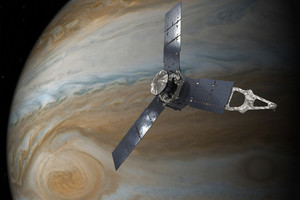Asteroid 3, the third asteroid to be discovered, by the German astronomer Karl Ludwig Harding (1765–1834) in 1804. Its diameter is 234 km. Juno is of S type, with a rotation period of 7.21 hours. Its orbit has a semimajor axis of 2.67 au, period 4.36 years, perihelion 1.98 au, aphelion 3.35 au, and inclination 13°.0.
NASA spacecraft and mission to Jupiter. The probe launched in 2011 and has been in orbit around the gas giant since July 2016. Juno’s main goal is to improve our understanding of the Solar System’s beginnings by revealing the origin and evolution of Jupiter. Specifically, the probe is equipped with diverse instruments to conduct four primary missions: (1) to determine the amount of water in Jupiter’s atmosphere; (2) to measure composition, temperature, cloud motions, and other properties of Jupiter’s deep atmosphere; (3) to map Jupiter's magnetic and gravity fields; and (4) to explore and study Jupiter's aurorae. The Juno mission is the second spacecraft designed under NASA’s New Frontiers Program and the second long-term mission at Jupiter after the Galileo spacecraft. Juno has made several important discoveries, including that there are giant cyclones at the planet’s poles, that high-altitude clouds snow material onto Jupiter’s cloud tops, that Jupiter’s bands extend deeper into the planet’s atmosphere, that its core is larger and more diffuse than previously thought, and that the planet’s aurorae are different from those on Earth.

NASA ’s Juno spacecraft in orbit above Jupiter’s Great Red Spot.
Credit: NASA
A solar system asteroid (No. 3), diameter 268 km; approximate mass 2 × 1019 kg; rotational period 7.21 hours; orbital period 4.36 years. It was discovered in 1804 by K. Harding.
- upper percentage point
- upper quartile
- upper sideband
- upper-tail probability
- upper triangular matrix
- upregulation
- upright fold
- UPS
- upsampling
- upset
- Upsilon Sagittarii star
- upslope fog
- upstream
- upthrow
- upthrust
- uptime
- Upton Warren
- UPVC
- up vector
- upward compatibility
- upward continuation
- upward lightning
- upwelling
- Ur
- uracil